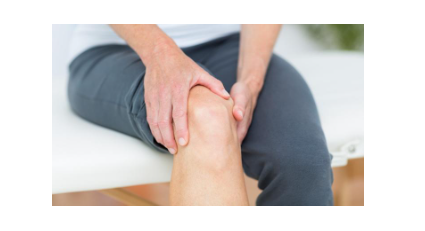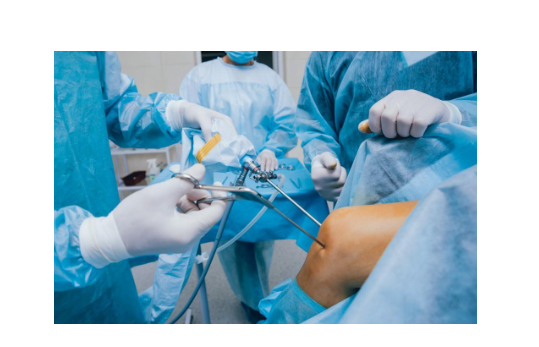By: Geraldus Sigap
Joint pain can be debilitating, affecting one’s ability to perform even the simplest of daily tasks. Whether it is due to an injury, arthritis, or overuse, finding relief becomes a priority for many people. Traditionally, joint surgeries were often invasive, involving large incisions, long recovery times, and considerable discomfort. However, with advancements in medical technology, minimally invasive procedures like arthroscopy have revolutionized the way joint pain is treated.
Arthroscopy is a surgical technique used to diagnose and treat joint problems. This procedure is particularly beneficial for those suffering from chronic joint pain, as it allows doctors to both see inside the joint and fix issues using very small incisions. The procedure offers significant advantages over traditional surgeries, such as shorter recovery periods, minimal scarring, and less pain post-surgery.

Figure 1. Joint pain
This procedure is commonly performed on the knees, shoulders, elbows, hips, and ankles. Whether you are suffering from a torn meniscus in the knee, cartilage damage in the shoulder, or persistent hip pain, arthroscopy might be the ideal solution.
Arthroscopy can address a variety of joint issues. Some of the most common conditions treated by this procedure include:
- Torn Cartilage: Cartilage, the smooth material that allows your joints to glide, can be damaged from injury or wear and tear. Arthroscopy can trim or repair torn cartilage, especially in the knees and shoulders.
- Ligament Repairs: Ligaments are the fibrous tissues that connect bones to each other. If torn, they can cause instability and pain. Arthroscopy is often used to repair ligaments, especially in sports-related injuries, such as anterior cruciate ligament (ACL) tears.
- Joint Inflammation: Conditions such as synovitis, where the lining of the joint becomes inflamed, can be treated using arthroscopy. This reduces pain and restores mobility.
- Loose Bone or Cartilage: Sometimes, fragments of bone or cartilage may break off within the joint, causing discomfort and limiting movement. Arthroscopy can be used to remove these fragments safely.
One of the primary reasons arthroscopy has gained so much popularity is because it is a minimally invasive procedure. Some of the key advantages include:
- Smaller Incisions: Traditional joint surgery often requires large cuts, leading to more tissue damage and longer recovery times. Arthroscopy, by contrast, uses incisions so small that they barely leave a scar.
- Less Pain: Since the procedure is less invasive, patients typically experience far less pain post-surgery compared to traditional methods. This also reduces the need for strong pain medications after the surgery.
- Faster Recovery: The recovery time for arthroscopy is significantly shorter. Most patients can return to their normal activities in a few weeks, although complete recovery may take a bit longer depending on the severity of the issue.
- Lower Risk of Complications: Because the procedure is minimally invasive, the risks associated with infection and other complications are also reduced.
Outpatient Procedure: In many cases, arthroscopy is performed on an outpatient basis. This means you can go home on the same day as your surgery, without the need for an extended hospital stay.

Figure 2. Arthroscopy procedure
Before undergoing arthroscopy, your orthopedic surgeon will conduct a thorough evaluation, which may include imaging tests such as an X-ray or MRI to assess the condition of your joint. You may be asked to refrain from eating or drinking for several hours before the surgery.
The procedure itself typically takes around one to two hours, depending on the complexity of the problem being treated. Local or general anesthesia is used to ensure that you remain comfortable throughout the procedure. After the surgery, the small incisions are closed with stitches or sterile strips, and you will be given instructions for at-home care.
Although recovery after arthroscopy is quicker than traditional surgery, it is still important to follow your doctor’s instructions to ensure the best results. Here are some general tips for post-arthroscopy recovery:
- Rest and Elevate: Keeping the joint elevated and rested is crucial in the first few days after surgery to reduce swelling and promote healing.
- Physical Therapy: Your doctor may recommend physical therapy to help strengthen the muscles around the joint and restore its full range of motion. It is important to follow through with therapy to prevent stiffness and ensure a smooth recovery.
- Medications: Over-the-counter pain relief medications are often sufficient to manage any discomfort, although your doctor may prescribe something stronger if necessary.
- Watch for Signs of Infection: While the risk of complications is low, it is still important to monitor the surgical site for any signs of infection, such as redness, swelling, or unusual discharge.
Many people experience significant relief from joint pain after undergoing arthroscopy. Whether it is repairing a torn ligament or removing damaged cartilage, this procedure can restore function and allow individuals to return to their daily activities with far less pain. However, it is important to remember that every patient is different. While some may experience immediate relief, others may require additional rehabilitation to achieve optimal results.
It is important to note that after undergoing arthroscopy, especially for lower body joints such as the knee or ankle, patients may not be able to walk immediately. Depending on the extent of the procedure and the recovery plan, it may take several days or even weeks before normal walking is fully restored. Patients are often advised to use crutches or a walker during the initial recovery period and gradually increase their mobility under the guidance of a healthcare professional. For this reason, it is recommended that patients plan ahead and arrange for extended leave from work or other activities in advance, ensuring they have enough time to recover without the pressure of returning too quickly. Proper rest and following the rehabilitation plan are essential to a successful recovery.
At RS Abdi Waluyo, our team of highly trained orthopedic specialists is dedicated to providing the best possible outcomes for our patients. Using the latest technology, we ensure that every patient receives personalized treatment tailored to their unique needs. The modern facilities are equipped with advanced surgical tools, ensuring that procedures are performed with precision and care. In addition, our multidisciplinary approach to treatment means that you will receive comprehensive care from diagnosis to recovery, with specialists working together to achieve the best outcomes.
For those dealing with joint pain, our orthopedic specialists will provide a thorough evaluation to determine if arthroscopy is the right option for you. With a commitment to patient safety, comfort, and long-term results, RS Abdi Waluyo is the ideal place to regain mobility and enjoy a pain-free life.
Resources
- 5 Tips for Returning to Sports After Arthroscopic Knee Surgery: Performance Orthopaedics and Sports Medicine: Board Certified Orthopedic Surgeons [Homepage on the Internet]. [cited 2024 Oct 7];Available from: https://www.performanceorthonj.com/blog/5-tips-for-returning-to-sports-after-arthroscopic-knee-surgery
- What to Expect Before, During, and After Knee Arthroscopy: Coastal Empire Orthopedics: Orthopedic Surgeons [Homepage on the Internet]. [cited 2024 Oct 7];Available from: https://www.jonathanshultsmd.com/blog/what-to-expect-before-during-and-after-knee-arthroscopy
- Arthroscopy – Mayo Clinic [Homepage on the Internet]. [cited 2024 Oct 7];Available from: https://www.mayoclinic.org/tests-procedures/arthroscopy/about/pac-20392974
- Arthroscopy – OrthoInfo – AAOS [Homepage on the Internet]. [cited 2024 Oct 7];Available from: https://www.orthoinfo.org/en/treatment/arthroscopy/
